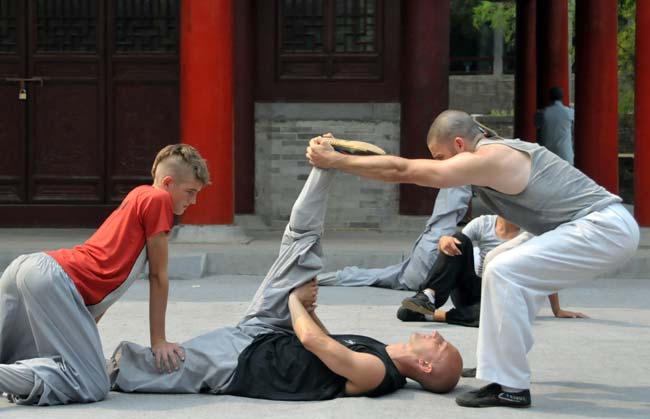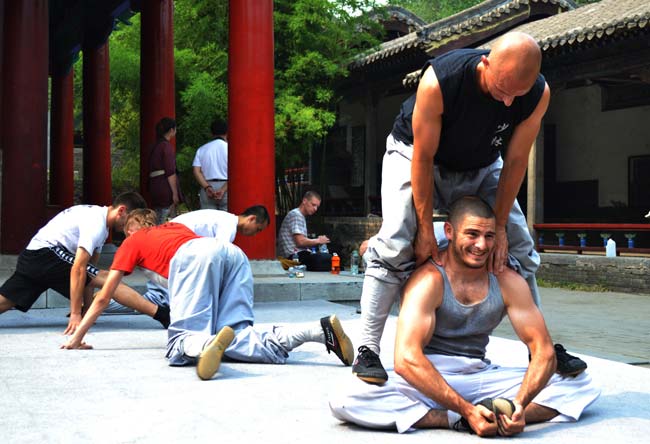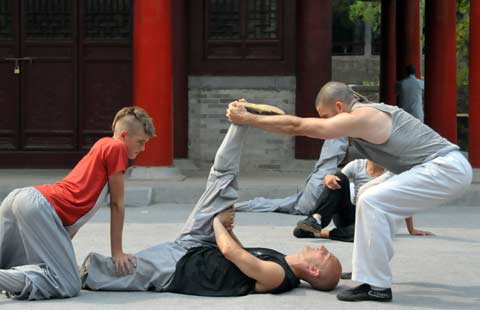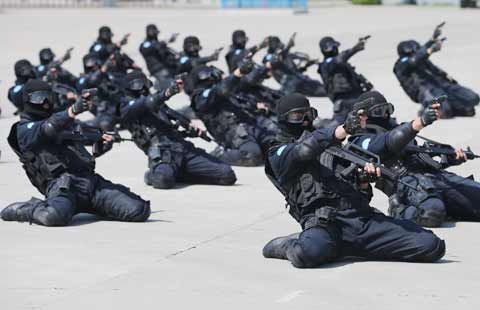Shaolin: Fists of fame
Updated: 2014-07-28 20:37
By Hou Liqiang and Qi Xin
|
|||||||||||
 |
| Canadian Cale Klesko stretches and warms up his muscles with help from his friends before a kung fu class in the 1,500-year-old Shaolin Temple in Henan province. ZHANG LEILONG / CHINA DAILY |
|
Style By Hou Liqiang Shaolin kung fu is considered the largest school in Chinese martial arts. It contains hundreds of extant styles including barehanded and armed techniques, each boasting routines that promise to improve health as well as fighting prowess. Shaolin kung fu is not styled to be as aggressive as some of the other schools in China. Governed by moral codes that preach tolerance and mercy, Shaolin practitioners promote the use of their skills for self-defense. Disciples are encouraged to use the kung fu to improve their physical and mental fitness and to reduce aggression as much as possible. Shaolin Temple abbot Shi Yongxin once said that its kung fu “is for cultivating values according to Buddhist doctrine”. |
University student Maxim Kojevnikoff is visiting Shaolin Temple for the fourth time.
He had planned to join his friends in Wutaishan Mountain in Shanxi province, but decided to return to the renowned 1,500-year-old temple in Dengfeng city of Henan province.
"For me, learning kung fu in Shaolin is like lying on the beach and enjoying the sunshine," the 22-year-old Kojevnikoff said.
"Every time I return to Moscow from Shaolin, I feel rejuvenated."
The journalism major at Russian State Social University teaches Shaolin kung fu at a martial arts center in Moscow. He is still deciding between a career in journalism and martial arts. But he is sure he wants to continue teaching kung fu part time after he graduates.
Kojevnikoff is one of more than 2,000 foreigners who head to Shaolin Temple every year to learn kung fu. The number of visitors usually peaks during the summer vacation.
"Many come as a group. There are more than 20 groups every summer," said the temple's abbot, Shi Yongxin.
|
Game for growth By Hou Liqiang and Qi Xin Shaolin Temple is taking a major step forward in its digitization by developing a gaming app to teach users kung fu on their mobile phones. "The temple can use its 'warrior monks' as the main characters of the mobile phone game," Lin Xiaosong, chairman of Dengfeng Tiandizhizhong Network Development Corp, which manages the Shaolin brand, told Xinhua News Agency. "The game will integrate kung fu with swords and sticks to teach martial arts interactively, so that users won't have to climb Songshan Mountain where Shaolin is located to learn its kung fu." Lin said Shaolin is still studying the app and there are no further details on the project. Shaolin was the first temple in China to take its expansion into the digital age. It registered the domain name of its website in 1996, even before e-commerce giant Alibaba did so, and the portal was launched in March 2001. The temple's English website was launched on May 1, 2010. In 2008, the temple started using online market Taobao, where its Shaolin Medical Book is sold at 9,999 yuan ($1,600) each. In 2013, Shaolin began to offer an online Guiyi, a Buddhist ceremony. Buddhists can get their certificates in one and a half months without going to Shaolin, said Zou Xiang, manager of the website of Shaolin Temple. Zou said more than 400 Buddhists have successfully taken part in Guiyi with the help of the online service. In August 2010, the temple opened its account on social networking and micro-blogging service Sina Weibo. The account has about 68,000 followers. A similar account was opened in 2012 on the Tencent platform and has about 86,000 followers. A team of about 10 people in shifts work 24 hours a day to update the accounts, Zou said. "We update at least 30 pieces of information on Weibo, WeChat and the website every day," Zou said. After messaging service WeChat became popular in 2013, Shaolin also opened an account for it on April 22, 2014. The WeChat account has more than 3,400 followers. "More than 1,000 of these followers are from foreign countries," Zou said, adding that the temple is planning to launch bilingual content to better involve these foreign followers. Shaolin abbot Shi Yongxin said it is not the monks but lay Buddhists who are working with the temple's official website and WeChat and Weibo accounts. There is Wi-Fi in all office areas of the temple and almost all its young monks use smartphones and computers. Shi Yongxin also said cataloguing of the books in the temple's library has gone digital and monks at the temple have access to the electronic books of the Capital Library of China and National Library of China. Shi Yanjia, a monk at the temple, said he usually spends one hour surfing the Internet in the evening. "In the evening, we (the monks) search for materials on the Internet. We also watch some movies or TV series," said the 32-year-old. |
"A lot more come in twos or threes. There are such foreigners almost every day."
The abbot said many of the visitors also learn kung fu in the training schools nearby.
The visitors cite many reasons for going to Shaolin. Kojevnikoff said he heard about the temple and fell in love with martial arts after his parents sent him for classes when he was a child. His teacher later took him to Shaolin.
Canadian Cale Klesko said he goes to Shaolin to practice kung fu and Chinese culture, as he is dealing with an increasing number of Chinese companies in his work as an engineer in management consulting.
Kung fu also helps him keep "a balance between the body and the mind", the 30-year-old said.
Virginia Suen from Hong Kong said she learns kung fu to strengthen her body.
"I feel I am in good spirits after practicing kung fu," the 42-year-old assistant in an investment company said.
Many of the visitors also said they developed an interest in kung fu after watching movies about Shaolin as children. These include the 1982 movie, The Shaolin Temple, starring Jet Li.
Since 2001, Damo, a center for martial arts studies established in Russia, has organized kung fu students to Shaolin Temple every year. Rogov Viaches Lav, the chairman of the center, said at least 300 people studying in the center have visited Shaolin. The 46-year-old also said the center has trained more than 1,000 people in Shaolin kung fu.
Authorized by Shaolin, the center is now building a Shaolin-style complex in Russia.
"There will be Buddhism halls, training rooms, meditation rooms and a healthcare center," he said.
The facility will be built in line with Chinese feng shui geomancy concepts, he said.
The Russian said he developed an interest in kung fu after watching Chinese martial arts movies as a boy.
"Kung fu does not solely belong to China. It belongs to the world. It offers us opportunities to know each other. We should thank kung fu," he said.
The Damo center in Russia is one of the dozens of overseas centers authorized by Shaolin. According to Wang Yumin of the foreign affairs office of Shaolin Temple, there are now more than 40 such centers worldwide.
Shi Yongxin said there are hundreds or even thousands of Shaolin centers around the world, if "unauthorized ones set up by Shaolin's disciples and students are included".
Going abroad
More Shaolin monks are also going overseas to take part in cultural exchanges.
 |
|
Cale Klesko, a Canadian citizen, helps his friend warm up before a kung fu session in Shaolin Temple on July 3. |
Today's Top News
Developers placing bets on casinos overseas
Scrutiny on iPhone data access
Russian fighter jet crash kills pilot
US-Russia relations frosty
Harsher safety measures urged amid scandal
Drills to have 'little impact' on civilian air services
Revision of decree protects military airports
Experts slam Japan's bid to break order
Hot Topics
Lunar probe , China growth forecasts, Emission rules get tougher, China seen through 'colored lens', International board,
Editor's Picks

|

|

|

|

|

|





